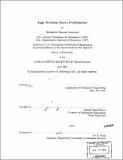High precision stereo profilometry
Author(s)
Aumond, Bernardo Dantas, 1972-
DownloadFull printable version (22.06Mb)
Other Contributors
Massachusetts Institute of Technology. Department of Mechanical Engineering.
Advisor
Kamal Youcef-Toumi.
Terms of use
Metadata
Show full item recordAbstract
Metrological data from sample surfaces can be obtained by using a variety of profilome try methods. Atomic Force Microscopy (AFM), which relies on contact inter-atomic forces to extract topographical images of a sample, is one such method that can be used on a wide range of surface types, with possible nanometer resolution (both vertical andlateral). However, AFM images are commonly distorted by convolution, which reduces metrological accuracy. This type of distortion is more significant when the sample surface containshigh aspect ratio features such as lines, steps or sharp edges or when probe and sample share similar characteristic dimensions. Therefore, as the size of engineered features arepushed into the micrometer and sub-micrometer range by the development of new high precision fabrication techniques, convolution distortions embedded in the images becomeincreasingly more significant. Aiming at mitigating these distortions and recovering metrology sound ness, we introduce a novel image deconvolution scheme based on the principle of stereo imaging. Multiple images of a sample, taken at different angles, allow for separation ofcon volution artifacts from true topographic data. As a result, accurate samplereconstruction and probe shape estimation can be achieved simultaneously. Additionally, shadow zones, which are areas of the sample that cannot be reached by the AFM probe, are greatly re duced. Most importantly, this technique does not require a priori probe characterizationor any sort of shape assumption. It also reduces the need for slender or sharper probes,which, on one hand, induce less convolution distortion but, on the other hand, are more prone to wear and damage, thus decreasing the overall inspection system reliability. (cont.) This research project includes a survey of current high precision metrology tools and an in-depthanalysis of the state of the art deconvolution techniques for probe based metrology instruments. Next, the stereo imaging algorithm is introduced, simulation results presented and anerror analysis is conducted. Finally, experimental validations of the technique are carried outfor an industrial inspection application where the characteristic dimensions of the samplesare in the nanometer range. The technique was found to be robust and insensitive to probe or shape geometries. Furthermore, the same framework was deemed to be applicable to other probe based imaging techniques such as mechanical stylus profilometers and scanning tunneling microscopy.
Description
Thesis (Ph.D.)--Massachusetts Institute of Technology, Dept. of Mechanical Engineering, 2001. Includes bibliographical references (leaves 186-190).
Date issued
2001Department
Massachusetts Institute of Technology. Department of Mechanical EngineeringPublisher
Massachusetts Institute of Technology
Keywords
Mechanical Engineering.